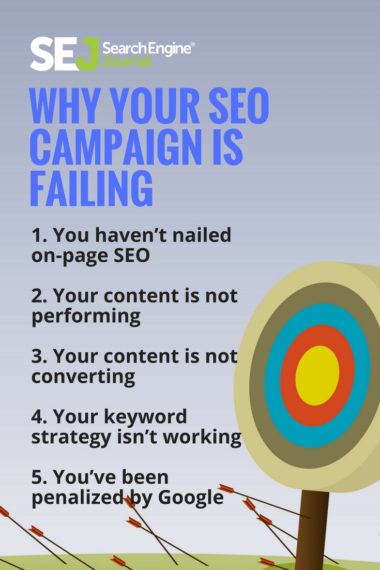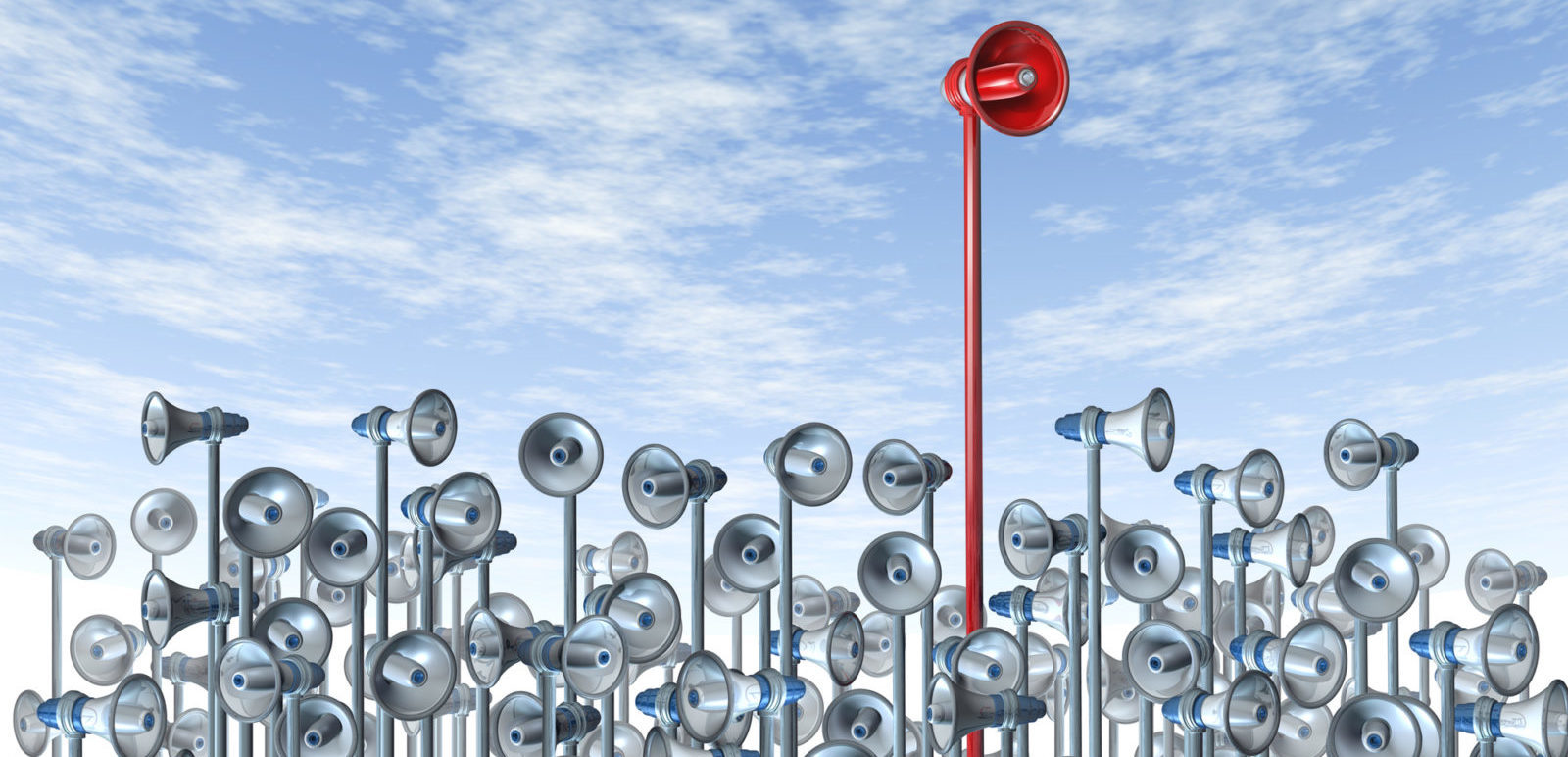Are your SEO efforts hitting rock bottom? It may be time to revisit your strategies before it’s too late.
2017 is expected to be big for SEO. Important trends such as Accelerated Mobile Pages (AMP), RankBrain, mobile-first indexing, and the latest developments in Google’s algorithms will continue to set the course over the next 12 months. This will make a lot of old strategies and techniques obsolete, and will shift the ground for those whose SEO strategies are not up-to-date.
If your performance is waning already, here are seven top reasons why that might be the case, and how to change what you’re doing to get back on track.
Most Common Reasons SEO Campaigns Fail (And What to Do About Them)
1. Your website is outdated
A few main aspects of your website may be the cause for it to rank poorly. These are:
Website Architecture
A website structure that is too complex and requires users to make three or more clicks to get to the page they’re interested in is a common reason for increased bounce rates. Difficult navigation between pages and drop-down menus with too many links are the other main culprits.
Some best practices you should aim for when working on your website structure are:
- Main pages should be available from a header on the homepage
- Site structure should follow a logical and predictable order
- Use breadcrumbs to help with navigation
- Optimize HTML and CSS code to improve crawlability
By improving your site structure you may be awarded sitelinks by Google’s algorithm, which in turn will significantly improve your performance in SERPs.
Website Speed
Site speed is an important ranking factor. Just by improving the loading time for your site, you may see improvement in ranking. One of the best ways to assess speed is Google’s PageSpeed Insights tool. Run a test for your domain to see suggestions for improvement.
Common things that can be improved are:
- Upgrade your server or invest in better hosting
- Use external hosting (e.g. Dropbox or AWS) for large files
- Resize and compress images
- Use a Content Delivery Network (CDN) to deliver images
- Minimize redirects
- Clean up your code
Responsiveness (Mobile-First Indexing)
Mobile is quickly overtaking desktop in how people are searching and browsing the internet. That makes the responsiveness of your site and its speed particularly important.
This is reflected in a few recent moves by Google: the creation of the AMP project in 2015 and, more recently, the announcement on mobile-first indexing. To stay on top of these trends, your website should conform to the speed requirements in the previous section as well as:
- Use responsive design or be a dynamic serving website
- Work with AMP principles
- Be built as a Progressive Web App (PWA)
- Be visually pleasing and feature easy navigation and links
HTTPS
Finally, moving your website from HTTP to HTTPS to offer greater security may provide you with an additional boost in ranking. And by moving to HTTPS you can then also transition to HTTP/2 which may soon become a “must” too!
2. You Haven’t Nailed On-Page SEO
Some common on-page SEO elements and best practices which you may be missing or need to update could be dragging your website down. Here are the most important ones:
URL
A poor URL structure is confusing to both users and search engines. Make sure that your URLs are:
- Clear, simple, short, and descriptive (avoid numbers)
- Follow a logical order that mimics your website structure — make URLs guessable
- Include main keywords (but not excessively)
- Separate different words in URLs with hyphens, instead of underscores, but do not overuse hyphens either
Meta Tags
Adding good and relevant meta tags is important for the way your page will appear in SERPs. Your title tag and your meta description are the two most important aspects of your meta tags. To improve your meta tags:
- Include the primary and secondary keyword in the title tag + brand name
- Don’t go above 60 characters in your title tag
- Use unique title tags for every page
- Aim for relevance, avoid keyword stuffing
- Make the H1 heading different from the title tag
Link Structure
On-page SEO is not complete without a good link structure and without cleaning up your broken links. The more internal links you have that go deep and are relevant, the better for users and for your ranking. Here are some things to keep in mind for your internal links:
- Link between pages and posts on your site including to “deep” content
- Use relevant links
- Make anchor text comprehensive, natural, and relevant (do not over-optimize)
- Use follow links
- Do not link excessively
You should also take care of broken links, especially if you have hundreds of pages on your website. Broken links hurt the indexing of your page, drive away users, and increase the bounce rate.
Schema.org and RankBrain
Machine learning, or RankBrain, is now Google’s third most important ranking factor for websites. This means that the easier it is for the algorithm to interpret your page, the better your page is likely to rank. To anticipate and meet the growing demands that RankBrain will be placing on websites, you should consider implementing a schema markup on your website.
Schema markups are a way of structuring the data on your website so that it can be understood universally by search engines. Schema works as a “map” that indicates to search engines what type of information is contained in each element of your page. By knowing what things on a website mean, search engines can better pick out the content that will be useful and helpful to users in response to their search queries.
3. You’re Not Building Links Properly
Beyond internal linking, building inbound links is vital for your site. It is considered the second most important ranking factor, with content being the first.
Implementing just any inbound link strategy won’t cut it — links need to be of good quality, coming from authority domains.
Consider the following when working on your link building strategy:
- Vary anchor text when publishing guest posts
- Do not participate in link networks
- Disavow any low-quality links pointing to your site
- Focus on generating content on your website that is valuable and can be used as a resource by others so that they will want to link back to it
- Discover your competitors’ backlinks and learn about their techniques and sources
- Build relationships, ask for links, and suggest that mentions are turned into links
Of course, outbound links from your website are also an important asset you can use to offer further value to your users and increase their appreciation of your content. They can also be an asset in establishing partnerships with other high-value websites.
4. Your Content is Not Performing
Your content remains the most important ranking factor. You can get all other factors right, but without high-quality content, your SEO will continue to fall flat. Common reasons your content is not performing and ranking are:
Thin, Short, or Duplicate Content
The Panda update of Google’s algorithm primarily targeted websites with thin content that added little value to visitors. So invest in producing content that your readers love and make sure to optimize it for relevant keywords.
Avoid using duplicate content as a rule, though by now Google can easily tell which instances of duplicate content are intended to manipulate and which are for greater visibility, for example.
You may also experience issues with duplicate content because of how your URLs are set up but there are ways to fix these.
Irrelevant Content
Along with being longer and fuller, your content also needs to be relevant to user intent. Through Hummingbird, RankBrain, and other algorithm updates, Google is increasingly aiming at understanding user intent and is getting better at taking it into consideration.
When choosing keywords to optimize for, consider what the user intent behind those keywords could be. For example, user intent could be navigational, informational or transactional, and your content should ideally match that intent to yield results.
5. Your Content is Not Converting
If your site is ranking and driving traffic, but your content is not converting, that’s still an SEO failure — your content should serve your business purpose.
To create content that converts users, you should pay attention to:
Marketing Personas and The Buyer’s Journey
The lack of buyer personas in your content marketing strategy will make it difficult for you to create content that speaks to the different groups of people that would be interested in becoming customers.
To improve the conversion of your content:
- Create detailed buyer persona profiles
- Create a model of your buyer personas’ journey down the funnel
- Create loads of content that speaks to each person and is tailored to the particular stage of their journey
Mirage Content
If you don’t understand your customers well or if your writers do not have enough expertise, you are at risk of creating mirage content. This type of content lacks depth, expertise, precision, and specifics.
Mirage content may seem to work for a while because it typically makes a big promise, but it always ends up disappointing. That’s because it usually does not feature concrete problems and their solutions.
The main advice for avoiding mirage content is: hire or work with writers who have expertise in your field, good analytical skills, and write in a compelling way. Alternatively, if you don’t have the expertise, interview experts and then turn these interviews into expert content.
6. Your Keyword Strategy Isn’t Working
A carefully developed keyword strategy can help you match user intent closely. Some common problems that may occur with keyword strategies are:
- Targeting keywords that are too competitive
- Not enough search volume for target keywords
- Not using long-tail keywords
- Overusing keywords
- Not using your analytics to make informed decisions
Strive to create a keyword strategy that doesn’t simply focus on keywords with high search volume. These are harder to rank for, on the one hand, and often have a significantly lower conversion rate when compared to long-tail ones. Long-tail ones are also closer to, again, user intent and natural expression.
You may also want to consider implementing a hub and spoke keyword strategy. This strategy is based on the idea of a hub (short-tail keyword focused content) being in the middle of numerous spokes (closely related long-tail keyword focused content).
The hub piece contains the full information about a topic and also serves as an index that links to various sub-topics or ‘chapters’ that go into greater detail and explain particular concepts — the spokes.
If implemented with care, this strategy works well because it:
- Provides exhaustive information on a topic
- Offers structured content with a lot of internal linking — this allows search engines to easily understand which piece is the hub and which is the spoke
- Improves visitor retention — users can move easily from hub to spoke and back, which in turn increases the clickthrough rate, and reduces the bounce rate
- Increased click-through signals to Google that this content is of high quality which helps it rank higher for the short-tail keyword, creating a self-reinforcing cycle
7. You’ve Been Penalized by Google
Ultimately, your SEO campaign may be failing because you’ve been penalized by Google. There are tens of reasons you may get penalized, though the most common ones are because of:
- A Panda penalty targeting low-quality content
- A Penguin penalty targeting bad backlinks
- A Mobilegeddon penalty targeting websites that are not mobile-friendly
- A Top-heavy penalty targeting websites that feature too many ads above the fold
How do you find out if you’ve been penalized?
A sudden drop in rankings for your brand name or organic traffic is one indication that you may have been penalized. Your PageRank has dropped for no particular reason or your entire page has been removed from Google’s cached results.
What should you do? If you’ve gotten penalized, don’t panic. Try to establish the cause for your penalty. Depending on the nature of your penalty, you may even need to suspend other SEO activities temporarily and focus your efforts entirely on getting the penalty lifted.
Conclusion
SEO is changing to reflect the changes in search behavior, developments in search algorithms and AI, and the explosion in the production of content.
It is becoming more and more integrated with other marketing approaches in order to yield a fuller experience to users. SEO trends in 2017 will be about greater alignment with user behavior.
To stay on top, revisit all the main areas of your digital strategy and evaluate what’s working and what isn’t. The most important thing to win at SEO is to keep working on it regularly, instead of letting it catch dust and having to catch up hurriedly the next time Google updates their algorithm.
 Image Credits
Image Credits
Screenshots by Alexander Kesler: taken on January 2017
Featured image via DepositPhotos.






